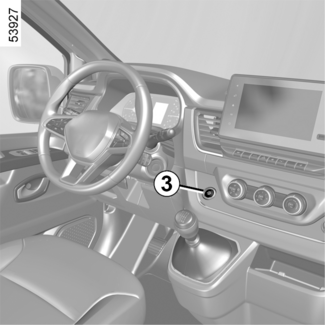Fuel tank
Fuel tank
Introduction
WARNING
To fill up with fuel, the engine must be off (and not only on standby in the case
of vehicles equipped with the Stop and Start function): you must switch off the ignition STARTING, STOPPING THE ENGINE, STOP AND START FUNCTION.
Fire hazard.
WARNING
Do not mix even small amounts of petrol (unleaded or E85) with diesel.
Do not use ethanol-based fuel if your vehicle is not compatible with this fuel.
Do not add reagent to the fuel – otherwise you risk damaging the engine REAGENT TANK.
If you wish to add an additive to the fuel, use a product approved by our Technical
Department.
Consult an approved Dealer.
WARNING
Persistent smell of fuel
If you notice a persistent fuel odour you should:
- stop the vehicle when traffic conditions allow it and switch off the ignition;
- switch on the hazard warning lights and ask your passengers to leave the vehicle and stay clear of the traffic;
- contact an authorised dealer.
WARNING
No modifications whatsoever are permitted on any part of the fuel supply system (electronic
units, wiring, fuel circuit, injectors, protective covers, etc.) as this may be dangerous
(unless undertaken by qualified Network personnel).
WARNING
Please note when working close to the engine that it may be hot. The engine cooling
fan may also start at any moment. The  label in the engine compartment reminds you of this.
label in the engine compartment reminds you of this.
Risk of injury.
WARNING
Fuel filler cap: this is a specific type.
If you have to replace it, make sure it is identical to the original cap. Contact
an approved Dealer.
Never place the cap near a source of heat or flame.
Do not wash the filler area with a high pressure washer.

Useful capacity of fuel tank: approximately 17.60 gal (80 litres).
Open the front left-hand door to open the flap A.
Use the cap holder 2 on the flap A during filling to hold the cap 1 in place.
Fuel grade
Use a high-grade fuel that complies with the legislation in force in each country.
It must comply with the specifications shown on the label located on the flap AENGINE IDENTIFICATION, ENGINE SPECIFICATIONS.
Filling with fuel
With the ignition off, insert the nozzle and insert it fully before turning it on to fill the fuel tank (risk of splashing).
Keep the nozzle in this position throughout the entire filling operation.
When the pump cuts out automatically at the end of the filling procedure, a maximum
of two further filling attempts may be made, as there must be sufficient space in
the fuel tank to allow for expansion.
Make sure that no water enters the fuel tank during filling.
After filling, refit the cap 1 and close the flap A to prevent any water or foreign bodies from entering the system.
Always make sure that the cap 1, the flap A and its perimeter remain clean and free of dust, mud, dirt, etc.
Tip
Fuels that comply with the European standards with which vehicle engines marketed
in Europe are compatible ENGINE IDENTIFICATION, ENGINE SPECIFICATIONS.
Special case
When the vehicle has been stationary for around three months, you must add fuel to prevent damage to the fuel pump.
To do this, with the ignition off, fill up with fuel or add at least approximately
2.20 gallons (10 litres) then start the engine to operate the pump and renew the fuel in the circuit.
If it is not possible to add at least 2.20 gallons (10 litres) of fuel due to the
fuel level in the tank, drive the vehicle until the tank has capacity.
Running out of fuel on diesel versions

Vehicles with key/remote control
- Turn the ignition key to the "On" position MRUNNING IN and wait for a few minutes before starting to allow the fuel circuit to be primed;
- turn the key to D position. If the engine does not start, repeat the procedure;
- if the engine does not start after several attempts, please contact an authorised dealer.
Vehicles with card
With the card in the passenger compartment, press the start button 3 without pressing any of the pedals. Wait a few minutes before starting. This will
enable the fuel circuit to be primed. If the engine does not start, repeat the procedure.